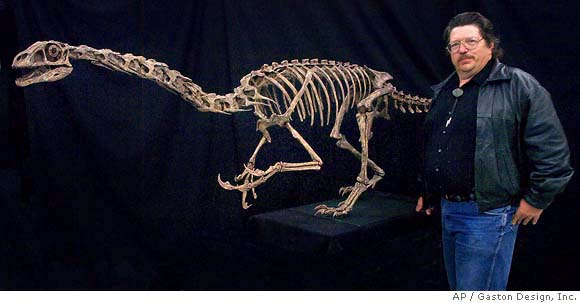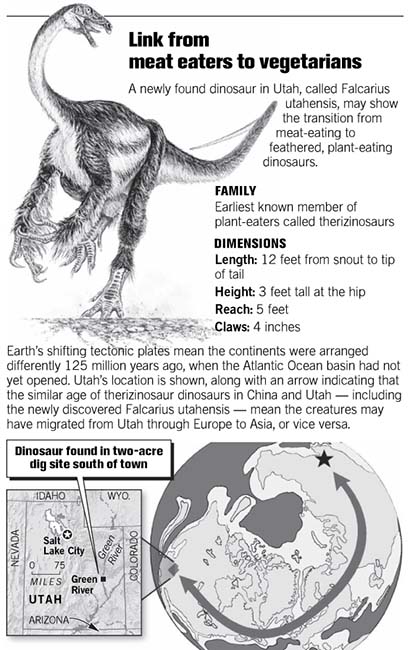
Carnivore or herbivore?
Newly discovered dinosaur called 'evolution caught in the act'
of dietary shift
David Perlman, Chronicle
Science Editor
Thursday, May 5, 2005
Fossil bones of a new tribe of feathered dinosaurs that
died by the hundreds 125 million years ago are giving scientists
fresh insights into the evolution of the lineage from fierce
carnivores to placid plant-eaters.
A mass graveyard on the side of a Utah mesa, where more than
1,700 bones have already been discovered, also shows the vast
range of the dinosaur world so long ago, when the drifting
continents of Asia and America were linked together as a single
land mass, scientists say.
After three years of digging, a team of University of Utah
paleontologists announced the discovery of the bizarre dinosaur
species Wednesday during a telephone news conference and in a
report being published today in the journal Nature.
It was "evolution caught in the act," said Scott Sampson,
chief curator of the University's Museum of Natural History as
he described the birdlike creature, barely more than 3 feet tall
at the hip as an adult and 12 feet long from snout to tail.
"An amazing evolutionary transition," said James Kirkland,
state paleontologist at the Utah Geological Survey.
Formally named Falcarius utahensis -- for "Utah sickle-maker"
because of its sharp, curved 4-inch claws -- the creature had
ancestors that were relatives of the voracious meat-eating
velociraptors of movie fame, Sampson said. Yet Falcarius is also
a primitive early member of the dinosaur group known as
therizinosaurs, some of which may have dined on fish as well as
plants.
The therizinosaurs are widely known from fossil beds in
China, but the Utah fossils are the first of the group ever
discovered in the Western Hemisphere, a surprising indication of
their wide range. And whether the Utah creatures were still
eating meat or had given it up in favor of plants -- or perhaps
were eating both -- is unknown, Sampson said.
However, he said, "With Falcarius, we have actual fossil
evidence of a major dietary shift, certainly the best example
documented among dinosaurs. This little beast is a missing link
between small-bodied predatory dinosaurs and the highly
specialized and bizarre plant-eating therizinosaurs."
The legs clearly were beginning to change from swift-running,
prey- chasing limbs to ones bulky enough to carry a larger body,
Sampson said.
The teeth show evolutionary changes, too, he noted, from the
sharply serrated shapes needed for cutting meat to broader,
leaf-like shapes that were better for shredding leaves. And the
gut was changing, expanding to a size big enough for fermenting
plants to make them digestible.
But the feathers on Falcarius were really "proto-feathers,"
said Lindsay E. Zanno, a Utah graduate student and member of the
excavation team. "The feathers obviously did not evolve for
flight. They may have existed at first for regulating heat, or
as mating signals, or as camouflage."
Just how the dinosaur form changed from predator to
plant-eater still poses a mystery, Sampson said, and speculating
about the problem "means working outside the realm of science."
But Falcarius, clearly descended from meat eaters, may well
have emerged on the scene when the environment was changing, too
-- from a landscape dominated by ferns and pines to the advent
of flowering plants on a large scale, Sampson said.
"Here was a new edible resource to be exploited," he said,
"an open ecological niche, perhaps, that may have made Falcarius
become a devoted vegetarian."
To Kevin Padian, a leading paleontologist at UC Berkeley, the
Utah discovery is highly significant -- both for providing fresh
evidence of the transition from meat-eating to plant-eating in
the dinosaur lineage, and for demonstrating the geographical
spread of the life forms on what have at times been widely
separated continents.
From the presence of Falcarius fossils in Utah, however, it
now seems clear that the varied therizinosaur species was spread
across both Asia and North America at a time when the two
continents were joined and the beasts and their descendants
could migrate far and wide.
"It shows an evolutionary connection of life between the
continents," Padian said. "There was lots of back and forth, and
it's been a two-way street, so the more you look, the more you
find."
The dinosaur site was excavated and tunneled on the side of a
mesa near the south central Utah town of Green River, and it has
already yielded enough bones to account for hundreds, if not
thousands, of bodies.
But its rich trove, which Kirkland found in 2001, might never
have been discovered at all if it hadn't been for a confessed
criminal.
A professional fossil dealer in Moab named Lawrence Walker
had sold some bones from the site to a Denver collector,
Kirkland recalled, and when Kirkland was introduced to the
dealer in 1999, he told Walker how important they were.
"Once he figured out he had a new dinosaur, he realized
scientists should be working the site," Kirkland said. "His
conscience led him to get his stuff to me."
It was illegal to dig at the site without a permit, however,
and Walker was indicted in November 2002. He pleaded guilty,
served five months in prison and paid a $15,000 fine.
Kirkland, Sampson, Zanno and all their colleagues are
properly permitted -- and they're still digging on the mesa.


Page A - 2
URL: http://sfgate.com/cgi-bin/article.cgi?file=/c/a/2005/05/05/MNGTBCK6SV1.DTL